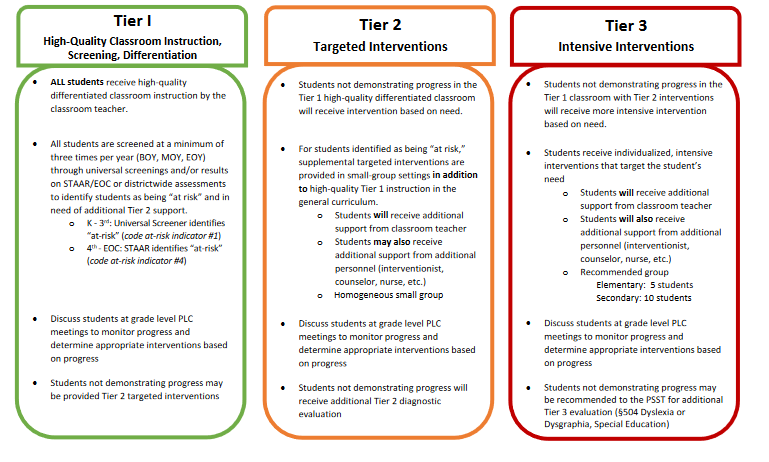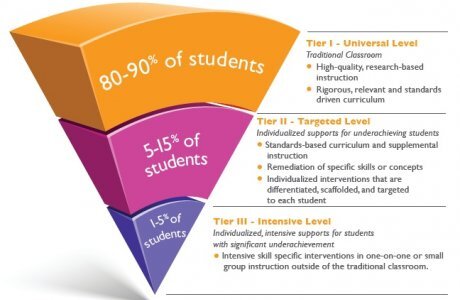How are you Responding to Student Intervention (RTI)
Response to Intervention (RTI) is a tiered approach to education and support for students with varying levels of learning supports. Through the three tiers, students receive more gradually more individualized instruction from a teacher to meet their level of learning needs while frequently monitoring results and responding to current data.
Tier I
Tier I, II, III Texas Overview
This approach starts with high-quality classroom instruction for all students, together with periodic screening. Many times in K12 classrooms there is an initial screening based on scientific research. Through this screening process, students are continuously assessed in order to measure their rate of progress. This initial step should ideally take no-longer than eight weeks. Students achieving acceptable levels of growth are still monitored and Teacher Professional Development is key to provide best practices in the classroom. Ongoing support for teachers ensures every student receives high-quality instruction.
Tier II
Students who need extra support are then selected to receive more intensive, targeted instruction in small groups in addition to their regular curriculum. The critical point is the specific scaffolding that helps young students in the group. Data is necessary at this point to pinpoint the exact supports needed to provide appropriate scaffolding during the lesson. These are small 30min lessons of targeted curriculum-aligned content. Many times its small group but there are some times 1:1 supports are necessary for individual needs. This could be during reading groups or writing 1:1 supports.
Tier III
Students who are making gains during intervention cycles or individualized instruction are then taken through further evaluation to be considered for alternative support. Tier II may include an increased amount of time on assignments, a diverse set of materials, or pullout intervention. Progress monitoring for this tier may occur more regularly and once again aligned with content standards. This tier can also include intensive instruction for individual students consisting of at least two half-hour sessions a week for 2 - 3 months. Through this RTI approach, we can ensure that students can progress through educational supports prior to referral. It is also important to notice that teachers also need support throughout this process. eCoaches can provide a second set of eyes and alternative ideas that will ultimately support the classroom. Check out “A New Approach to Teacher PD by Ei360” which explains how ecoaches can support teacher that need (RTI) help in the classroom.
Criticism of RTI
RTI Chart by Edmentum
A vital criticism of the RTI approach is that it places the onus of additional work on the teachers. Which many times, teachers are alone in the classroom working to create individual supports alone in the classroom can be a challenge. We all know that under the RTI approach, they are responsible for the idea, implementation, and documenting results for each support. Also, some teachers are just not trained for tiered instruction. Taking on the responsibility for implementing all three tiers in their classrooms, can be overwhelming for the new teacher. While valid, it is the responsibility of the educational institution to ensure that teachers are not overwhelmed by the workload and have coaches who can help them in the classroom, provide ideas, and coteach while planing for solutions. In addition, it is essential to remember that the RTI approach is currently what most schools have adopted as a segway to suggesting services.
Conclusion
While extensive research studies all show the potential benefits of the RTI approach, it is crucial to tailor the method to the specific needs of the education program and school. RTI is often misunderstood as a cookie-cutter approach to education and critically under-utilized as a result. The strategy must be adjusted to suit the pre-existing culture, teaching style, and specific needs of the educational institution. Through proper implementation, however, the RTI approach is effective in allowing struggling students and struggling schools to support their student population.
References
http://www.rtinetwork.org
http://www.ascd.org/research-a-topic/response-to-intervention-resources.aspx


